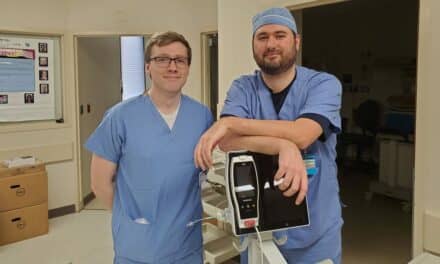With the pandemic accelerating HTM’s staffing exodus, here are some key ways to stay ahead of the crisis.
By Andy Lundin
The Great Resignation—an economic trend that describes the notable rise in quits rates post-2020—has significantly influenced the state of recruitment and retention.
Some major reasons why people quit their jobs en masse during this period included, “…low pay, a lack of opportunities for advancement, and feeling disrespected at work…” according to a 2022 survey from the Pew Research Center. However, for healthcare technology management (HTM) leaders who were already struggling with BMET employment and retention issues, this new and still ongoing trend has compounded the problem.
What follows are some of the top employment challenges the HTM field is currently facing and how they can be addressed, according to those in the know.
Early Retirement Woes
One staffing challenge that predates The Great Resignation, but was accelerated during the pandemic, has been the ongoing trend of more and more BMETs retiring. This, in tandem with fewer young professionals coming to fill the bench, has been a top-of-mind concern in this space.
Tony Cody, CHTM, director of technology management at Banner Health in Phoenix, says the pandemic has certainly been a factor, but believes there are other issues at play. “The largest contributing factor is that our most senior technicians are naturally aging out of the workforce and there hasn’t been a steady replenishment of qualified technicians to fill the need,” he says. “This trend was predicted and is proving true, but the pandemic exacerbated the issue.”
Chace Torres, CHTM, lead technician at SPBS, concurs. To him, the issue is multifaceted. “COVID presented an opportunity for people who were on the fence of retiring to go ahead and retire,” Torres says. “We’re already seeing that within probably the next five to 10 years, at minimum, there’s going to be a lot more people leaving the workforce because they’ve been in it so long. It’s their time.”
Blame it on workplace burnout, maintains Mike Powers, MBA, AAMIF, CDP, clinical engineering director at Intermountain Healthcare in Salt Lake City. With HTM professionals busier than ever during the pandemic—particularly in the early days of 2020—some biomeds decided to speed up their retirement plans. Not that it came as a shock, Powers says.
“I think that we expected to see a lot of turnover,” he says. “These are people who maybe could have waited until they were 67 to retire, and they instead retired at 65 because they were burnt out because of the pandemic.”
It’s something Samantha Jacques, PhD, FACHE, AAMIF, vice president of clinical engineering at McLaren Health Care in Grand Blanc, Mich., has witnessed firsthand. “The pandemic was obviously a factor,” she says, with those approaching retirement seeing it as a sign to take the plunge. “Other sites just had openings that were never filled,” Jacques says. After all, she points out, U.S. schools are graduating fewer and fewer BMETs.
“The environment left quite a few openings that then caused job hopping to occur,” she says. “Those in roles or cultures that didn’t meet their expectations used it as an opportunity to move. However, there still weren’t enough staff to fill all the openings, which then caused wages to rise and hospitals to [spend more money] to fill their positions.”
But all the money thrown at the problem hasn’t fully solved it, Jacques says. Simply put, “There aren’t enough people entering the field to match those leaving it.”
Addressing Hiring Concerns
Indeed, the influx of BMET retirees has caused a greater abundance of job openings, which many biomed departments have struggled to fill. Like Jacques, Torres says it’s attributable to the lack of new applicants in this field.
“I know several hospitals, at least in my area, and I’ve spoken to several others that can’t find willing applicants,” Torres says. “They can’t even find people who are applying, and they have multiple positions open. There is obviously a shortage of incoming blood into the field.”
To help remedy the situation, Cody of Banner Health believes organizations should rethink their approach. Specifically, they should reevaluate the qualities that an ideal candidate possesses and not only consider those with college degrees, he says.
“Many organizations require specific degrees in order to be considered a candidate,” Cody says. “In my opinion, that eliminates a large portion of qualified individuals that have learned through experience and self-study. Where once there was a necessity of a college degree to acquire the necessary job skills, with today’s availability of resources, that’s no longer the case.
Officials at AAMI seem to agree, as evidenced by the association’s U.S. Department of Labor-backed apprenticeship program for prospective BMETs. The program, launched in March 2021, replaces a decades-old curriculum, and offers on-the-job training to “fresh off-the-street” apprentices, according to AAMI literature.
In the May/June 2022 issue of 24×7, which provided an in-depth look at the apprenticeship program, AAMI Vice President of HTM Danielle McGeary explained why it works. “The BMET apprenticeship allows organizations to train BMETs to their culture, in their environment, on their specific equipment, and with their tools and policies,” she told 24×7. “At the end of two years, the BMET is very ingrained in the organization which they trained at.”
It’s certainly a unique—and proactive approach—to managing the staffing crisis, many say. And to Mike Powers of Intermountain Healthcare, it also addresses a key part of the problem: identifying and understanding where biomeds are needed most. But he adds that the demographics of the region should also be considered.
“I think it’s very important for my workforce to mirror my patient population,” Powers says. “Whatever that demographic is, we should try to mirror that in our employee population.”
To do this—particularly in areas with diverse patient populations—he recommends considering nontraditional employees. Maybe applicants don’t have a background in HTM; maybe they don’t even have a foundation in STEM. But if they have talents to fill the open positions, they should be considered, Powers says.
Top Talent Retention
Focusing on addressing recruitment methodologies is only one piece of the proverbial puzzle. Knowing how to retain quality HTM professionals is another essential element to consider if an organization is seeking to overcome employment hurdles. One key factor that should be considered? Salary.
According to 24×7’s HTM Salary Survey 2021, while several major job categories saw median salaries grow nationwide last year, overall wages in the HTM field lagged, despite record-high inflation. Meanwhile, a plethora of job openings are waiting to be filled, leading some biomeds to consider job hopping, especially if the salary of a new opportunity is higher than their current one.
So, how might HTM leaders justify staff salary increases in a bid to retain talent? Consider training the techs. To Powers, training is simply an investment in your team. “It is one of those ways that you can keep [biomeds’] skills fresh and let them know that you really value their contributions,” he says.
Cody of Banner Health concurs, saying he believes implementing training programs will ultimately help with retention. Having training opportunities available will not only show your current HTM workforce that the organization has a vested interest in them, but it may also help justify salary increases, he says.
It’s a win-win scenario since it provides direct value to the institution, Cody says. “I also would look at developing and investing into BMET-to-imaging transitions, and peer-to-leader programs. “This also solves a need for a specific and highly trained technician and leader, and it allows for growth of the employees that may feel that they have no place to grow professionally.”
Considering Growth Opportunities
Indeed, another major incentive for those seeking jobs in the HTM field is opportunities for growth. “The majority of the biomed field wants growth opportunities because of what comes with it: benefits, salary, education,” says Chace Torres. “And, obviously, if you’re going for a managerial role, it gives you more opportunities to do more things.”
Powers’ workplace uses individual development plans—something he fully endorses. He says that these plans also help shape department succession plans—filling the employment gap when key personnel retire or resign.
Why Communication and Culture Are Critical
Money and growth opportunities aside, Samantha Jacques adds that there is no “one-size-fits-all” solution to overcoming employment retention issues. Every biomed department will have its own unique set of challenges, she stresses. Fortunately, she says that openly communicating with staff members may go a long way in retaining them and keeping them happy.
“You need to talk with them, openly and honestly, and ask them what they need and want,” Jacques says. “You then need to tailor solutions to your team’s needs. We all want a silver bullet to make it better; the only silver bullet is to build an open and honest relationship with your staff. Value them, empathize with them, and understand what they need. Balance that with what the organization needs and go from there.”
If, for instance, an organization is unable to increase salaries due to economic reasons, it’s important that staff members know that. Transparent communication with the HTM department, as well as offering possible solutions, may bolster staff positivity amid the challenging times.
Powers admits that advocating for his team, as well as being fiscally responsible to the organization, is no small task. “It’s a balance,” he says, and one that requires as much transparency as possible.
Maybe team members won’t be able to get raises this year, Powers says, but department leaders can communicate gratitude to them in other ways. Think educational programs, flexible work hours, or other special perks. Open communication—especially if it conveys gratitude—is part and parcel of a company’s work culture, Powers explains, and plays a major role in whether someone chooses to join or stay with an organization.
Jacques echoes the significance of being communicative in situations where it may help biomed better understand the state of the organization and its intentions for its employees. “We need to teach leaders the skills to communicate with their staff, empathize with what staff are going through, build strong missions and visions, and generally improve their organizational culture,” she says. After all, she says, employees “flock to great cultures” where they feel listened to and appreciated. And that’s a retention strategy that all departments can employ.
Andy Lundin is associate editor of 24×7 Magazine. Questions and comments can be directed to [email protected].
Deep-Dive Podcast
“The Bearded Biomed” (aka: Chace Torres) recently sat down with 24×7’s chief editor Keri Stephens, along with associate editor Andy Lundin, to discuss ways HTM leaders can retain top talent in the industry and current recruitment trends professionals are witnessing. This episode, and more, can be found online at rebrand.ly/prndprm.






I could not agree more with hiring individuals we overlooked in the past because they did not have a specific degree. I am a Group Manager for Clinical Engineering at Barnes Hospital in St.Louis, and we hire from within the hospital if we can. It has worked for us. I often have conversations with the housekeeping staff and patient care technicians who want to work in our department, and I advise them on what it takes to make a move. The most significant benefit I see at our Hospital is the tuition assistance program that helps people achieve their goals for advancement.